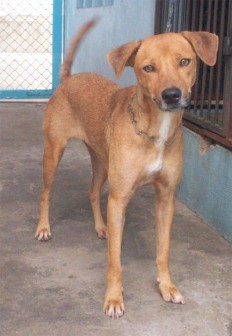I’ve kept this topic for last, on purpose. So many myths have been bandied about on this issue. Practically every ‘sudden’ canine death is attributed to a frog ‘blowing’ on the dog. Usually, there is a different cause of ailment and death, another reality.
The fact of the matter is that all toads have a bad taste and usually dogs keep far from them. I suppose there is some maternal teaching mechanism that plays a role, quite distinct from the personal experience that a dog would have acquired in dealing with frogs.

We have toads here in Guyana (I think of the Bufo marinus species) that do secrete a potent toxin which affects the heart rate and blood circulation in dogs. Death can occur within minutes.
The symptoms of this toad poisoning would depend upon the toxicity of the toad’s poison and upon the amount of poison absorbed. The signs will vary from merely hypersalivating (drooling) to convulsions, to absolute stiffening of the muscles (like a board), and then death. Cardiac arrhythmia (irregular heartbeats) usually accompanies toad poisoning.
Since the poison attacks the nervous system, the diaphragm – which plays an important role in the inhalation and exhalation of air (oxygen) – does not function well or at all. The animal begins to turn blue from the lack of oxygen. The dog literally suffocates.

Usually, by the time the owner arrives with the stiff, prostrate, comatose dog at the vet, the prognosis for recovery is not good. The vet will try to relax the board-like stiffness of the muscles with a sedative – an anaesthetic. Of course, one has to be careful, because it is dicey to give an anaesthetic to a patient which is already in a semi-coma or unconscious. Worse, once the anaesthetic wears off, the animal might relapse into the stiffness, and the breathing difficulties return. Anyway, it is clear that the therapy must be directed at the reinstating of oxygen intake through sustained breathing. The vet can give injections to improve breathing.
The important thing to do, if you feel that your dog absorbed the toad poison via the mouth, is to wash out the dog’s mouth preferably with a garden hose. You may wish to induce vomiting with hydrogen peroxide as described in Pet Corner of December 5, 2010. You must be prepared to administer artificial respiration. Then rush to your vet.
A specific antidote for the toxins in toad venom is not available. Earlier (see above), I mentioned that there is a lot of drooling (large quantities of salvia are produced); consequently, it is of therapeutic value to reduce the volume of saliva so that the victim does not aspirate saliva into its lungs. In this regard the drug atropine could be administered by your vet. More severely affected animals require more extensive therapy. For example, there are specific protocols which your vet will introduce to stabilize the irregular heartbeats. After you have done what you can at home, it is imperative that the poisoned dog receives professional care as soon as possible.
I think we have dealt at length with the various types of poisonings. Let us begin with something new next week.
Please implement disease preventative measures (vaccinations, routine dewormings, monthly anti-heartworm medication, etc) and adopt-a-pet from the GSPCA’s Animal Clinic and Shelter at Robb Street and Orange Walk, if you have the wherewithal to care well for the animals. Do not stray your unwanted pets, take them to the GSPCA’s Clinic and Shelter instead. If you do not wish your pet to have puppies or kittens, you may exploit the GSPCA’s free spay and neutering programme. If you see anyone being cruel to an animal, or if you need any technical information, please get in touch with the Clinic and Shelter by calling 226-4237.




